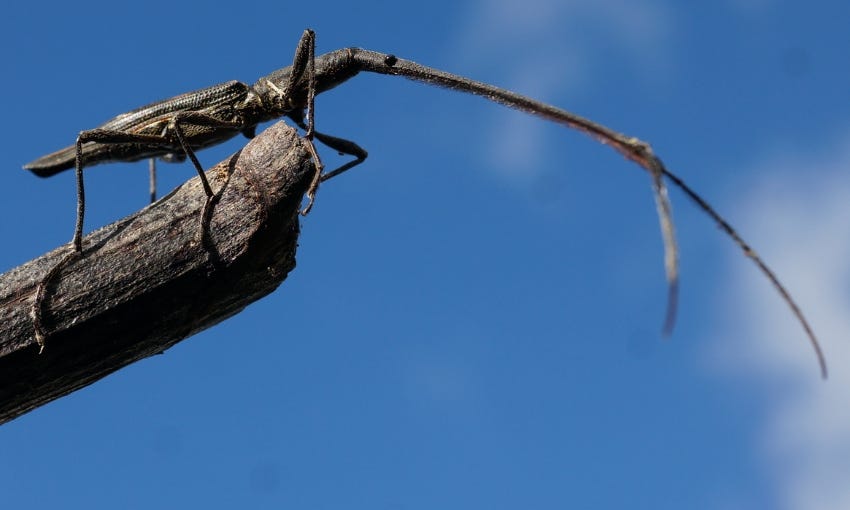Old trees still have new tricks in a climate changed world
Mature native forests bump up their wood growth in response to elevated CO2, new study finds.
Kia ora, welcome to Future Proof. Thanks for joining me. This week: the biodiversity of emojis, and New Zealand’s biggest climate polluters revealed. But first: old-growth trees offer an acorn of climate hope.
Rings within the forest release targeted streams of carbon dioxide. Image credit: Shomari Healy.
For seven years, researchers have been blanketing small pockets of a forest in the middle of the UK with elevated carbon dioxide – yes, that carbon dioxide, a greenhouse gas triggering climate change.
It’s an experiment to understand how mature trees respond to the levels of carbon dioxide we expect to see in 2050, and we’ve just got the first results.
We might expect mature, “middle-aged” trees – like the 180-year-old oaks in this forest – to have reached their limits, with not much capacity for growing any more wood.
But that’s not what scientists found. The increased carbon dioxide – which plants suck out of the air and use as food – triggered a growth spurt. “The increase in growth rate was quite significant – around 10% greater growth in total over seven years,” says Alan Jones, a forest carbon scientist at Scion. “This is equivalent to nearly two tonnes of extra tree growth per hectare per year, or approximately one extra tonne of carbon sequestered per hectare per year.”
In other words, it’s not just the young, fast-growing trees that can siphon planet-heating carbon dioxide from the atmosphere and lock it away in trunk and branch. Older, native trees can help us too.
“This could buy us a little time for climate mitigation and help moderate some of the immediate effects of climate change while we do it,” says Jones. It’s not a get-out-of-jail-free card – we still need to drastically cut down the emissions we’re pumping out into the atmosphere. What we shouldn’t cut down is our old-growth forests, especially since they can offer this extra helping hand.
This “carbon dioxide fertilisation effect” has been detected in controlled, young plantation forests before – but this is the first time it’s been studied in a natural, mature forest. The strength of the growth signal was “a pleasant surprise,” says Jones.
The results could also apply to New Zealand, says Jones, who set up precision instruments called dendrometers to measure tree growth as part of the study. Both countries have similar temperate climates, with native forests made up of slower growing hardwoods. “It is highly likely many of our native forests in New Zealand will also grow slightly faster in response to increased atmospheric carbon dioxide,” he says.
The UK forest site also has another similarity to lots of New Zealand ngahere: it’s “secondary woodland”, recovering from past logging activity. The strong growth response detected in the study site shows that forests don’t need to be pristine and untouched to respond to elevated carbon dioxide with a growth boost.
The experiment has been extended until 2031, and Jones expects to see “a year-on-year increased growth response”, while investigations will also shift underground to figure out what’s happening with the trees’ roots.
The research has been published in Nature Climate Change.
Takeout Kids is back with the stories of five tamariki and rangatahi growing up in their parents’ shops. In episode one we meet Priyan, who keeps the counter and stock in check at his family’s superette and bulk food store in Auckland. It’s his first week of school, and in class Priyan gravitates to the toy shopfront not unlike his parents’ own, where he plays the pretend version of the job they do for real. Follow Priyan as he deals with lessons in ABCs, cricket and making friends in the return of Takeout Kids. Made with the support of NZ On Air.
New Zealand’s biggest climate polluters
Fonterra takes the top spot among New Zealand’s biggest producers of greenhouse gas emissions for the fourth year in a row, according to data gathered by the Environmental Protection Authority. The top six – Fonterra, Z Energy, Mobil, Silver Fern Farms, BP and Todd Energy – produce just over half of the country’s greenhouse gas emissions counted under the Emissions Trading Scheme. Newsroom’s Marc Daalder digs into the data, and reports that this may be the final time this company-level data from farms is reported by the EPA. The government is ending reporting requirements for agriculture when it removes the sector from the ETS.
Meanwhile, the government will slash the number of carbon credits available in the ETS for 2025–2029. This reduction in permits-to-pollute will address an oversupply that saw recent auctions of credits fail to attract any bids. RNZ’s Eloise Gibson explains the decision, and what it means for petrol, electricity and gas bills.
Methane-busting red seaweed shows promise – but it’s not ready yet
If you watched Patrick Gower: On Ice last week, you would’ve seen the giant vats of red seaweed gurgling away down in Bluff. Across the ditch in Australia, the longest commercial trial of Asparagopsis seaweed to date found that cattle fed the additive reduced methane production by more than half over 200 days, The Guardian reports. It’s a promising result, but comes with plenty of caveats – the cattle in the study were on a feedlot, for example, while most of Australia’s and New Zealand’s cattle are out roaming far-flung fields, where it’s much trickier to feed a daily supplement. Plus, the commercial viability of the additive remains uncertain.
In other agritech news, a prototype methane-reducing vaccine from a US-based start-up, with support from Aotearoa’s AgriZeroNZ, has shown positive early results.
More stories
How have the seasons changed in your city? In mine – Christchurch – winter has warmed 2.2 times faster than summer, according to this Washington Post interactive.
What the heck is regenerative agriculture? I explain the latest climate buzzword on The Spinoff.
Elsewhere, RNZ’s Farah Hancock investigates regenerative agriculture claims from some of the country’s biggest agriculture players, and whether they count as greenwashing.
Can dirt clean up climate change? Farmers in Australia are trying to tap “nature’s carbon traders” – soil fungi – to suck up carbon dioxide from the air and stash it underground. (The New York Times)
Emissions-tracking smartphone apps are taking off – and straddling a fine line between encouraging thoughtful purchase decisions, and implying emissions are a problem only individuals can solve. (Bloomberg)
While electric vehicle sales plummeted this year due to government policy, we could still see an uptick as cheaper Chinese EVs enter New Zealand, Newsroom’s Marc Daalder reports.
The US will support a global plastics treaty that calls for a reduction in plastic production – a substantial policy shift for one of the world’s biggest plastic makers. (Reuters)
Limiting warming to 1.5°C is less about technology, and more about how quickly governments can ramp up effective climate policy, according to a new study. (Carbon Brief)
"As a New Zealander living in Sydney, The Spinoff helps me to feel in touch with what's happening back home. There's a great breadth to the content – and the enthusiasm from your contributors is palpable. I feel happy and proud to be a member." – Ian, Sydney
Whether living here or abroad, if you value our work please show your support by becoming a member today.
Giraffe weevil male. Image credit: strewick/iNaturalist (CC BY 4.0).
To finish this edition, check out the impressive schnozz on this pepeke nguturoa giraffe weevil, which is used for jousting with rival males. Lily Duval highlights these long-snouted stunners and a couple of other stand-outs from New Zealand’s 1,500 weevil species for Wilderness. In other six-legged news, The Washington Post does a data-deep-dive on the biodiversity of emojis, and finds them lacking in the invertebrate section. They’ve designed emojis for water bears, fireflies and cicadas – but I reckon a giraffe weevil emoji would go hard.
Have an unbeweevilably good week,
Ellen
Future Proof is looking for a sponsor!
Connect your brand with an insightful exploration of environmental news, reaching influential readers committed to sustainability and staying informed about the state of our natural world. Contact commercial@thespinoff.co.nz to learn more.
Got some feedback about Future Proof or topics you’d like covered? Get in touch with me at futureproof@thespinoff.co.nz












That's a fabulous result with the old-growth forests being so malleable and able to suck up so much carbon. I wrote about various rules for reforestation here: https://predirections.substack.com/p/rules-for-reforestation.
One of the key points is that we need to protect existing forests first, particularly old-growth forests. Losses of old-growth forests cannot be compensated for easily by reforestation.
"Unbeweeviliby" 🤣🤣👍